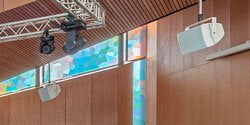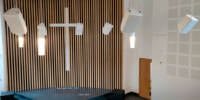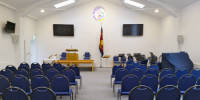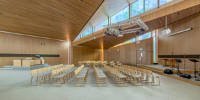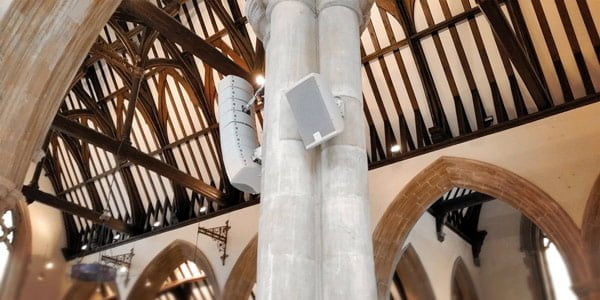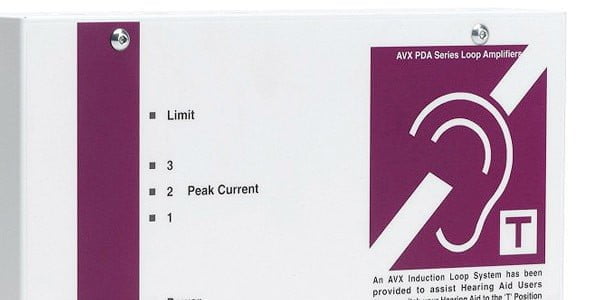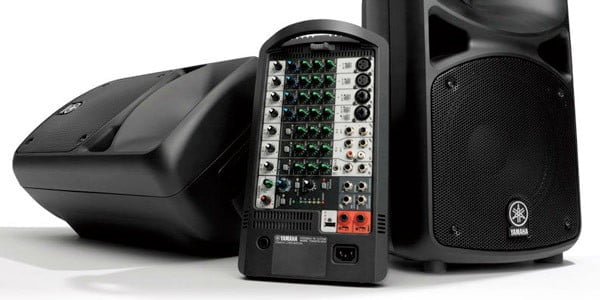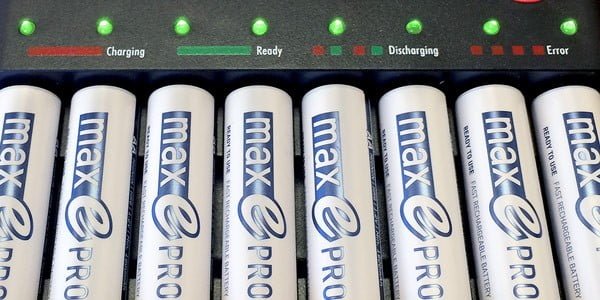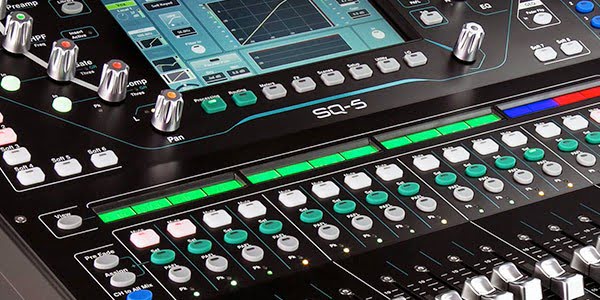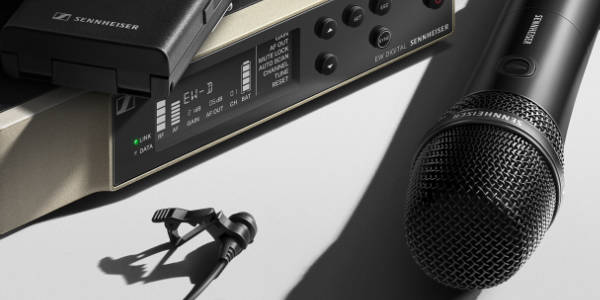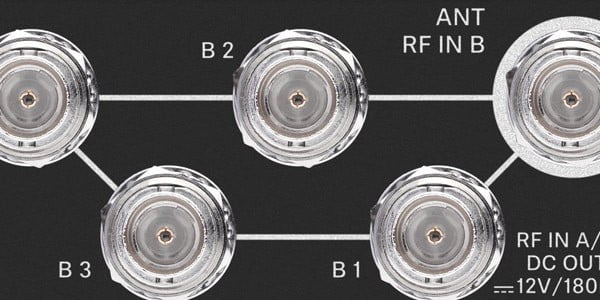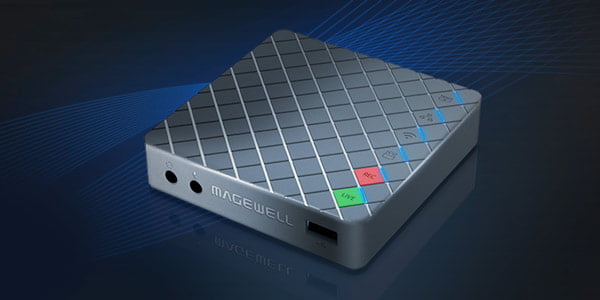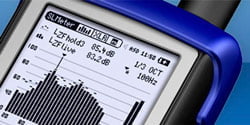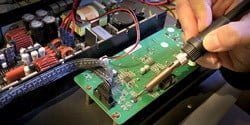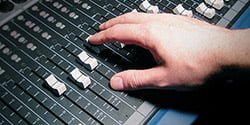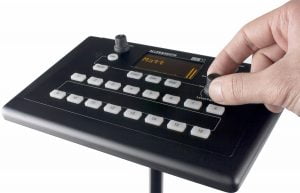
Most musicians or singers perform better if they can hear the sound of their own voice or instrument. This can sometimes be difficult when surrounded by other singers or instruments, and in a church context when there is a congregation singing (often towards you!). To combat this, most amplified bands will use some form of audio monitoring. At its most basic, it can involve at least one monitor speaker that band members can hear. Often, singers and musicians will share foldback monitor speakers between them, generally out of necessity, simplicity or practicality.
Good monitoring gives greater enjoyment for singers and musicians and encourages and improves their performance. Consequently, it improves the worship experience for the whole congregation.
Therefore, in an ideal world, each member of the band will have their own monitor with a unique ‘mix’ tailored to their requirement.
To achieve this, you need a specific output from the mixing desk to a monitor speaker (or in-ear monitor) for each person in the worship band. This would give each singer/musician their own ‘mix’, i.e. to hear exactly what they want to hear.
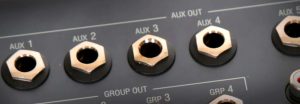
This output on a mixing desk for monitoring is often referred to as an auxiliary (or Aux) output. It needs to be able to be set on the mixing desk to ‘pre-fade’. Pre-fade means the signal is sent, from each individual input channel to a respective auxiliary output, before the signal reaches the channel’s fader (volume). This allows the auxiliary feed to the musician/singer's monitor to be unaffected by changes made to the channel faders when the mixing desk operator is adjusting the main mix to the PA loudspeakers. The aux/monitor mix is therefore independent of the main PA mix. This gives singers/musicians a reliable, unchanging monitor mix.
Foldback Monitor Speakers

Foldback monitor speakers are generally the easiest and least expensive way to allow the band to hear themselves. This can be a passive loudspeaker powered by a separate amplifier. Or it can be a powered (or active) loudspeaker that has a built-in amplifier. Both take a direct feed from an auxiliary output from the mixing desk.
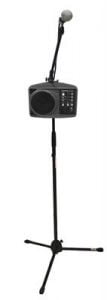 The latter has been much more popular in recent years because powered speakers generally offer more flexibility. They can be used stand-alone for any other PA use, e.g. children & youth work, fill speakers, mid-week meetings, Alpha, Film night, etc, etc. They can also be daisy-chained together.
The latter has been much more popular in recent years because powered speakers generally offer more flexibility. They can be used stand-alone for any other PA use, e.g. children & youth work, fill speakers, mid-week meetings, Alpha, Film night, etc, etc. They can also be daisy-chained together.
The drawbacks of any form of monitor speaker are that they take up quite a lot of, often very precious, space and... they are noisy. Of course, they do need to make ’noise’, and in large venues this isn’t often an issue, but in reverberant and/or small churches this additional volume can often create a problem. If monitor speakers are too loud, or there are too many, then the sound will reflect off the walls, or directly, to the congregation. This reflected sound is slightly delayed and usually has the effect of muddying the sound, and/or it seems like the main PA loudspeakers aren’t producing any sound.
One way to combat this is to have smaller monitor speakers closer to the singer/musician’s ears. This can allow it to be run at lower volumes, and of course, it takes up a bit less space. The Mackie SRM150 is a good example of a compact personal monitor, priced around £300. Following the logic of making loudspeakers smaller and closer to the ears ends up with …in-ear monitoring.
IEM - In-Ear Monitoring
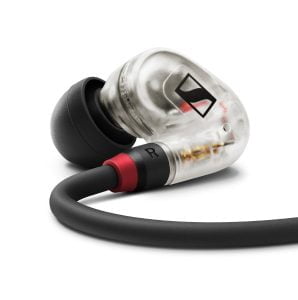 In-ear monitoring is fairly self-explanatory, and because many of us see it in action at events/conferences, and on television, it can feel like it’s the way to go to eliminate ‘on-stage’ noise and clear up clutter in the band area. The short answer is: it’s a good solution to these issues.
In-ear monitoring is fairly self-explanatory, and because many of us see it in action at events/conferences, and on television, it can feel like it’s the way to go to eliminate ‘on-stage’ noise and clear up clutter in the band area. The short answer is: it’s a good solution to these issues.
However, IEM is more involved and should be approached more cautiously than speaker monitoring as above. Part of this is that dealing more directly with people’s hearing brings a greater risk. And, therefore, the method of control and the setup are even more crucial. The other aspect of IEM is that most ambient noise is usually shut out from an IEM user; what they hear in their ‘mix' is even more important. For beginners, this can feel quite isolating and disconcerting. It is common to see users taking one earbud out to hear their surroundings (or the congregation). One way to get around this issue is to carefully use a local ambient mic to feed back into the in-ear mix (See the Allen & Heath ME-1 controller below).
Wired or wireless?
Most of us will have seen wireless IEM systems on TV or live and assumed that all IEM is wireless. Wireless IEM does offer a lot of benefits, but mostly they offer the lack of a wire! For pro-musicians, where budget is less of an issue, it represents a good option. For most churches shelling out circa £1000 per IEM, it is an expensive option, especially when you consider most of the band don’t need to go anywhere and often half of them are sitting down! Therefore, wired IEM offers a lower cost option for the same, or if not, a very similar monitoring experience.
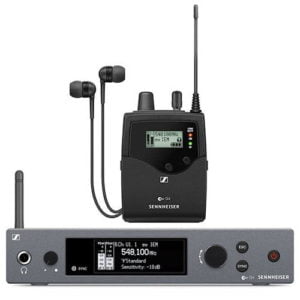 Wireless IEM:
Wireless IEM:
Sometimes, wireless IEM can be useful for those leading who may wander or need to move to different positions during the service. We recommend Sennheiser for wireless IEM applications. Their EW IEM G4 system (around £950 per IEM) is stereo but can be purchased as a twin receiver option and used in an independent mono set-up. This effectively gives two discrete mono feeds to two belt-packs for around £650 each.
I will also mention here, briefly(!), frequencies and licensing. Wireless IEMs are offered in the same frequency spaces as wireless microphones, but often take up slightly more bandwidth and are therefore recommended to be spaced apart from wireless mics. This inevitably needs to be in licensed frequency areas, so there is an additional cost involved for a licence. DM can help with this, so it is not necessarily an issue, just another consideration and cost. You can read more about this in our Radio Mic Frequencies & Licensing Tech Guide.
Wired IEM:
Wired IEM usually just involves using a suitable headphone amplifier with headphones/earbuds of your choice. The monitor feed (Aux output) from the mixing desk goes into the headphone amp, which will usually feature a volume control. Fischer Amps offer several types, the most simple of which start at around £60. Options that include a limiter start at about £160. Having a built-in limiter is something I would suggest looking for, as it does provide greater protection for hearing, particularly if the mix sent to the IEM is not controlled by the wearer. See ‘Control’ below.
Control
Traditionally, foldback monitors for musicians will be set up and controlled by a PA operator. In live touring and concert venues, this is often still the case, where a skilled professional will work closely with musicians day in day out and know what the performers want in their IEMs. In a church context, the reality of working with volunteer sound operators, musicians and singers, all on a rota, means there can often be a range of experience, knowledge and ability.
Analogue Control:
With an analogue mixing desk, there are few ways for a musician or singer to control the sound of their monitor besides hand signals or shouting at the sound operator. With larger mixing desk set-ups, the inputs are split to a separate ‘monitor mixing desk’ or sometimes, if available, use ‘direct outs’ from the mixing desk to allow separate musician mixing for monitoring. These require additional hardware and controllers for each musician/singer.
Digital Control:
Digital mixing desks have opened the door to far greater control of monitor mixing and IEM for the individual musician or singer.
Digital desks tend to have more outputs that can often be flexibly assigned for use as a monitor/auxiliary output. Most digital desks have the ability to be wirelessly controlled via an App on a tablet or smartphone. Many also offer specific ‘clutter-free' Apps for musicians to control their own foldback monitor or IEM. As the Apps are free and the wireless setup is low cost, there are few obstacles to gaining easy access to remote monitor control for all of the band.
Some manufacturers, like Allen & Heath, also offer separate hardware controllers that can be daisy-chained to the digital mixing desk via standard CAT cable. The Allen & Heath ME-1 controller (circa £575) offers level control, headphone (with limiter), monitor output, and a built-in ambient microphone.
Things to consider
Changing the way a music group/worship band operates can invariably lead to knock-on issues. Here are some practical, technical and perhaps 'pastoral' things to consider.
What should you hear in your monitor?
Moving a band to their own foldback monitor with individual control, all at the same time, can be difficult! Some won’t want or feel comfortable in controlling what they hear. They may prefer it to be set by the sound operator, or not know what they want to hear. Some simply may not want to hear themselves at all!
Often, a good solution is to phase in control. To start with, have the sound operator use a tablet and stand with musicians and singers and set the foldback levels together or in a visible, transparent way. This has several benefits. It allows the sound operator to hear what the musician/singer hears, it also allows the musicians/singers to see how level changes affect what they hear. If done carefully, this method can create trust between sound operators and the worship team. It then allows for more confident members of the worship team to connect using their own devices to set up their own foldback mix.
More Me!
The flip side to the above is when everyone wants control, and everyone turns their monitor up louder and louder. This is sometimes referred to as ‘more me’. Where a singer or musician fights to hear themselves over the rest of the band and feels they need more of themselves in their monitor. Often, what’s needed is rather than turning up what you want to hear, simply turn down what you don’t need. Practice, patience and understanding will all help to build trust and will be beneficial in getting a good balance for the musicians and the sound operator.
Moving to IEM
Moving to in-ear monitoring can be a great solution. But implementing it can be difficult. For those band members who haven’t used in-ear monitoring, it can initially feel alien and quite isolating (see the comments above about ambient mics to combat this). One tip is rather than everyone trying IEM all at the same time, it can make sense to start with one or two headphone amps and move them around the group over a few weeks, each musician/singer using his or her own headphones to see how they get on with them. You may find some do not get on with them, while others do. Those who do can often be an encouragement to others and assist in implementation.
As mentioned, IEM requires more mixing desk outputs, with far greater importance placed on control. Both of these aspects are much better catered for with a digital mixing desk. Therefore, my advice is to upgrade to a suitable digital mixing desk before you upgrade to IEM.



